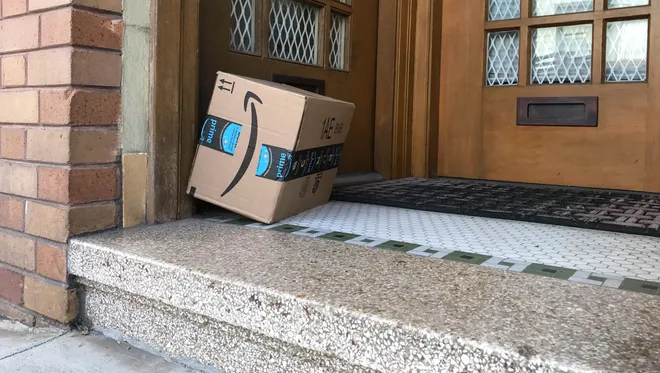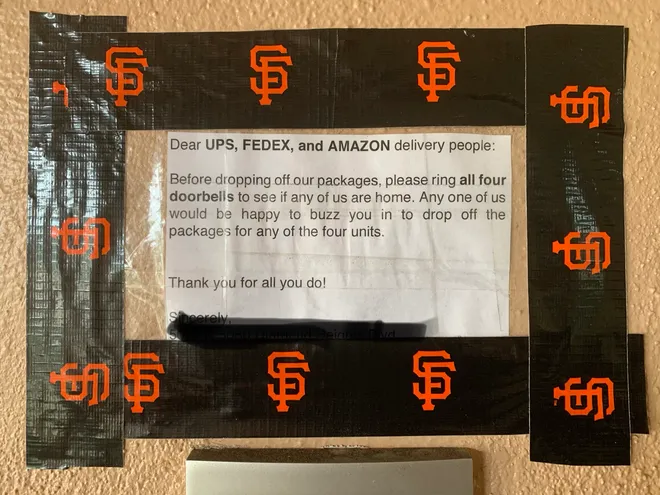You’ve gone through the coupon sites and we’re happy one of the codes offered actually reduced your online cart price by 10%. Now you’re expecting your package between 1-3 pm. You may even be working from home but it’s 3 pm and you swear you didn’t hear anybody drop your package off. There’s a good chance that you’ve been a victim of a porch pirate.
Footage of internet dubbed “porch pirates” stealing packages off of porches is easily obtained. Why? Because security cameras are there to record it all.
Package theft has been on the rise since 2019 and has risen considerably with the lockdown and increase of online shopping during the pandemic. One study of 2000 online shoppers found 36% had a package stolen and of that 44% have had more than one stolen.
Some people have tried to catch or punish these porch pirates using homemade devices like Mark Rober’s, an ex-NASA engineer, Glitter Bomb experiment. People have filled boxes full of poop, sprayed skunk essence, and the police have even used GPS.
Yet only 11% of victims report the police have caught the thief.
The question we had to ask ourselves is why the rate is so low? There are a few factors but at the heart of it, these porch pirates are showing the biggest weakness of any security system, physical or digital, and that’s people.
The Police Factor
Some of this low arrest rate can be blamed on the little priority that the police can dedicate to petty thefts like porch pirates. The average cost of the stolen items was $109 and often the cases have little to go off. Police must rely on neighbour witnesses which can easily be forgotten if the event didn’t stand out in their memories.
However, many cities now are more aware of the issue and are actively trying to catch package thieves, especially the repeat offenders with programs involving tactics like GPS bait boxes.
Police are increasingly calling for citizens to call in a porch theft no matter the value of the item or items stolen. In the end tracking cases, even unsolvable ones, will help them catch some thieves.
People are Unpredictable
Yet our research into reported thefts supported a study’s astonishing findings. The majority of these thefts occur in the middle of the day, by people who didn’t try to hide their identities, and weren’t scared away by signs that the homeowner was home or had cameras.
So the question remains if the crooks aren’t exceptionally smart and actually seem to lack the common sense to avoid looking straight into a camera, then why is the arrest rate so low?
One reason is the angle of the shot and the physical quality of the footage taken by cameras.
A facial recognition study trying to show how in-group recognition between the same race, same gender, or same political identification led to a more accurate recognition of these people’s faces than others in the “out-group”.
However, the study revealed something more basic which is more important. We all have a much harder time identifying the same face from different images.
Package thieves don’t line up patiently for the door camera to scan all the angles of their faces. So you get an incomplete picture which only sometimes combined with other clues such as a car’s make and colour can lead to a positive ID. You might even get a grainy shot or something taken from too far away that the police know it’s a long shot for recovery.
Just a slightly further angle from the camera and what could be used for a mostly certain ID is garbage. Unfortunately, that is how hard it is for package theft prevention.
The weakness of the system lies in the thief themselves, just an inch to the right and the footage is useless or they happen to be wearing a mask and the only thing left to do is contact the seller and hope for a refund.
Thankfully, most consumers (73%) in the study report that the sellers either shipped them a replacement product or issued them a refund.
But customers had more issues with the annoyance of having waited for their package only to have to go through customer service when they expected their package to come right to their door with no problems.
The Technical Factor
Besides sheer dumb luck with human behaviour, the cameras themselves can create difficulties correctly identifying package thieves.
There are 3 main parts to a security camera, and each has to be working optimally but to make many of these home burglary camera systems the parts can often malfunction.
Parts of a Camera – Basics
There are two general categories of security cameras:
- CCTV (closed-circuit television) – self-contained security system or wired
- IP security cameras (Internet Protocol) – wireless
Security cameras can be broken down into components that are designed to do one of three things:
- Record Events
- Store Recordings
- Transmit the recordings
These cameras can be wired or wireless. Wired cameras need to be physically connected to an in-device storage unit such as a DVR (digital video recorder) or an NVR (network video recorder). These recorders can then be physically uploaded to computers when you wish to view the footage usually through an ethernet internet connection. NVR is becoming the main recorder used as it doesn’t need to send footage to an external DVR unit to process as the NVR is inside the camera. This makes live camera feeds much faster.
Wireless cameras use WiFi to transmit the footage to any cloud-connected device and are becoming by far more popular than wired devices as they are integrated with mobile apps such as Google’s Nest or even devices like your Amazon Alexa. Obviously, the downside to this is your cameras depend on the WiFi strength and you could end up going a period without any security at all when your WiFi is out.
The Solutions to Porch Pirates
Delivery companies, online retailers, and consumers themselves all have motivations to fix the problem of porch pirates and so far there are a few common solutions.
The most obvious one is avoiding the problem of unattended packages altogether.
The postal service and many police jurisdictions give these guidelines:
- Choose shipping to require a signature
- Input a place of work to receive your package
- Get a neighbour or friend to hold your package for you
- Have your packages dropped off at the postal centre for you to pick up.
Of course, many of these things cancel out the benefits that direct-to-home shipping is supposed to create. You have to add another step to ensure your package’s safety which in the end many consumers will be unwilling or forget to do.
That’s why private solutions like lockboxes and digital mailboxes have also evolved to ensure package delivery safety. The main problem with these solutions is the expense for homeowners and sadly, human error again.
Who knew it would be a simple refusal by some delivery people to add that extra step of ringing the doorbell to see if the homeowner is home or using a lockbox if there is a note requesting it.
Despite this note, residents claim that very few deliveries actually use the bell.
The case of Amazon
Amazon, being one of the largest shippers has had to come up with their own solutions, to varying degrees of success. You may have heard of their first solution, Amazon Key, which caused some PR problems involving invasion of privacy. It involved a special lock on your door that could notify you when a delivery person was at your door to allow special access just to drop off the package.
To be clear, the delivery person wouldn’t have to wait for you to okay the delivery. The alert would go out and then they can swipe an unlock key on their phones that connect to your $249 Smart Lock and Cloud Cam system.
That was in 2017 and it fell off of Amazon’s radar pretty quickly.
Customers apparently weren’t as keen to be “a closer part of the Amazon family” and let them have access to their homes.
They also tried a similar in-car delivery option that lets the worker open and leaves your package in your car for you. But the system only works on certain models and the car has to be at the house which for the most part means you aren’t.
The last thing they’ve tried is the Amazon Locker which suffers from limited space and again negates the primary benefit of delivery in the first place.
Even Amazon is having trouble solving the problem of porch pirates and the solution doesn’t seem close to finalized.
Could Physical Security Have a Place on Porches
All of these attempts to fix the problem rely on faulty digital retroactive solutions that rely on limited evidence for low-cost crimes.
Security cameras still suffer from their biggest weakness which is that they are cameras. Only real people can really prevent theft before it happens.
The solution is easier from Homeowners Associations. They can collectively hire security that checks packages, clears visitors, and patrols the neighbourhood eliminating the porch package problem.
But what about security for individual households?
Affording full-time security is just not in the cards for most two-income households, but we still try to help when we can. If you live in the Bay Area and we have guards nearby at businesses or other HOA they help keep an eye out for suspicious behaviour.
Having a security presence nearby can have a ripple effect on neighbouring streets and houses.
You can contact us with your neighbourhood area and we’ll check if we’re near your street to keep an eye out for your packages.
Conclusion
As online shopping becomes even more popular, porch piracy isn’t just an occasional case of petty theft. Over one-third of Americans have experienced package theft at least once and studies only predict it to increase. If technology isn’t as foolproof as homeowners think it is, a new security system will need to evolve through the chain of custody from retail to doorstep.
There might need to be infrastructure put in place to derail porch thefts but to get it done, first people are going to have to figure out who is responsible for paying for it.


